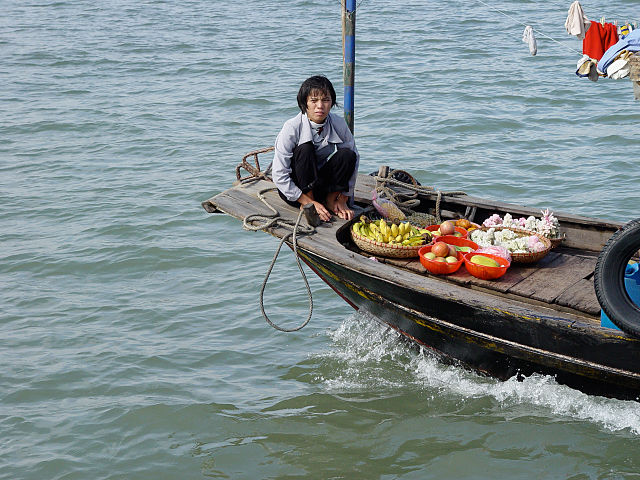Hạ Long Bay (Vịnh Hạ Long)
Hạ Long Bay or Halong Bay (Vietnamese: Vịnh Hạ Long, IPA: [vînˀ hâːˀ lawŋm] (listen)) is a UNESCO World Heritage Site and popular travel destination in Quảng Ninh Province, Vietnam. The name Hạ Long means "descending dragon". Administratively, the bay belongs to Hạ Long city, Cẩm Phả city, and is a part of Vân Đồn District. The bay features thousands of limestone karsts and isles in various shapes and sizes. Ha Long Bay is a center of a larger zone which includes Bai Tu Long Bay to the northeast, and Cát Bà Island to the southwest. These larger zones share a similar geological, geographical, geomorphological, climate, and cultural characters.
Hạ Long Bay has an area of around 1,553 km2 (600 sq mi), including 1,960–2,000 islets, most of which are limestone. The core of the bay has an area of 334 km2 (129 sq mi) with a high density of 775 islets. The limestone in this bay has gone through 500 million years of formation in different conditions and environments. The evolution of the karst in this bay has taken 20 million years under the impact of the tropical wet climate. The geo-diversity of the environment in the area has created biodiversity, including a tropical evergreen biosystem, oceanic and sea shore biosystem. Hạ Long Bay is home to 14 endemic floral species and 60 endemic faunal species.Historical research surveys have shown the presence of prehistoric human beings in this area tens of thousands years ago. The successive ancient cultures are the Soi Nhu culture around 18,000–7000 BC, the Cai Beo culture 7000–5000 BC and the Hạ Long culture 5,000–3,500 years ago. Hạ Long Bay also marked important events in the history of Vietnam with many artifacts found in Bai Tho Mountain, Dau Go Cave, Bai Chay.500 years ago, Nguyễn Trãi praised the beauty of Ha Long Bay in his verse Lộ nhập Vân Đồn, in which he called it "rock wonder in the sky". In 1962, the Ministry of Culture, Sports and Tourism of North Vietnam listed Ha Long Bay in the National Relics and Landscapes publication. In 1994, the core zone of Ha Long Bay was listed as a World Heritage Site according to Criterion VII, and listed for a second time according to Criterion VIII.
- 1 Etymology
-
2
Overview
- 2.1 Location
- 2.2 Climate
- 2.3 Population
- 3 History
- 4 Geology and geomorphology
- 5 Ecology
- 6 Awards and designations
-
7
In literature
- 7.1 Ancient tales
- 8 See also
- 9 References
- 10 External links
Links
Images Gallery
-

-
 Hạ Long Bay
Hạ Long Bay
-

-

-
-
-

-

-

-
-
-
-

-
-
 Panorama of Hạ Long Bay, taken on Monkey Island, 2013
Panorama of Hạ Long Bay, taken on Monkey Island, 2013
-

-
 Thien Cung grotto
Thien Cung grotto
-
 Fisherman's house, Hạ Long Bay, Vietnam
Fisherman's house, Hạ Long Bay, Vietnam
-
 Floating fishing village
Floating fishing village
-
 Statue of Buddha inside a Halong cave erected in 16-17th century
Statue of Buddha inside a Halong cave erected in 16-17th century
-
 Karst formations of Hạ Long Bay.
Karst formations of Hạ Long Bay.
-
 Sung Sot caves
Sung Sot caves
-
 View of Halong Bay
View of Halong Bay
-

-
-

-

-

-

-

-

-

-

-

-

-
-

-

-

-

-

-

-

-

-

-

-

-
-

-
-

-

-

-

-

-

-

-

-

-

-

-

-

-

-

-

-

-

-

-

-
-

-

-

-

-

-

-
-

-

-

-

-

-

-
-
-
-

-

-

-

-

-

-

-
-

-
-
-
-
-

-

-

-

-

-
-

-

-

-

-

-

-

-
-
-
-

Comments
Share your experience with others and write the first comment about the location




















































































































